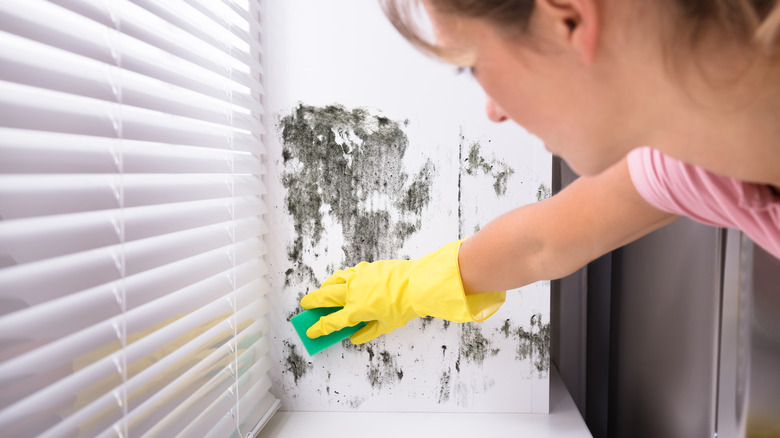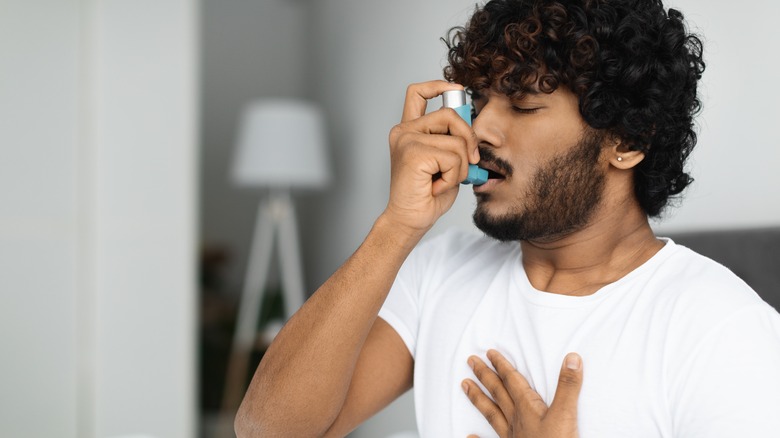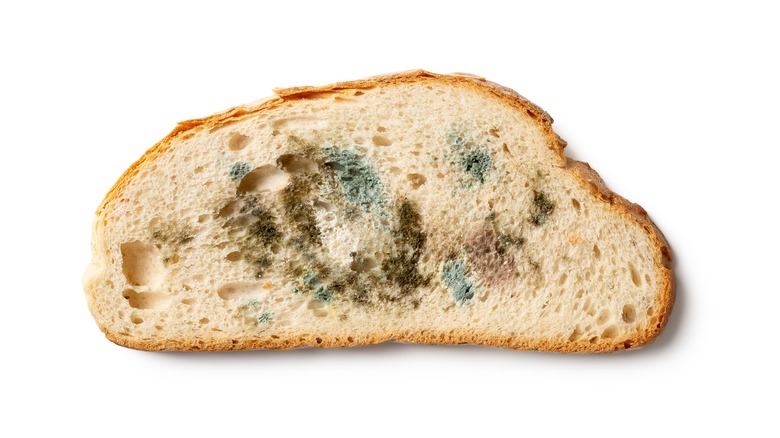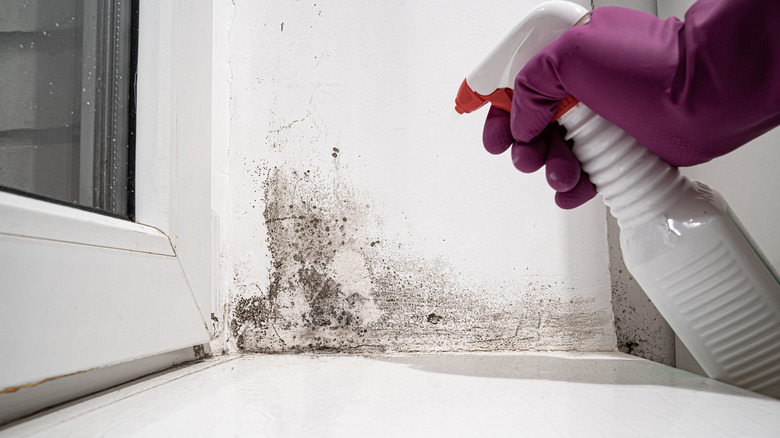How Dangerous Is Black Mold Exposure For Your Health?
There are many types of mold, each with its own unique characteristics and growth habits. Black mold, or Stachybotrys chartarum, is a fungus commonly found in indoor environments (via Medical News Today). It grows in damp and moist areas and may have a grey, green, or black appearance, per Forbes.
Mold can enter indoor environments through a variety of means. According to the Centers for Disease Control and Prevention (CDC), airborne mold spores can be carried into buildings through air vents, windows, and doors. Water leaks and floods can also introduce mold into indoor environments, as mold thrives in damp and moist conditions. Mold can also grow on building materials and furnishings that have been exposed to moisture, such as wallpaper, ceiling tiles, and carpet. Additionally, mold can be introduced into indoor environments through air conditioning and HVAC systems, or humidifiers. As far as black mold is concerned, it commonly appears around areas like kitchen and bathroom sinks, showers, and washing machines, per Forbes.
It is important to address moisture problems promptly and to remove mold as soon as possible if it is found in order to prevent its spread and minimize health risks.
How black mold inhalation can affect your health
According to the Centers for Disease Control and Prevention (CDC), black mold produces toxins known as mycotoxins, a diverse group of toxic compounds. Symptoms of mold inhalation can include headaches, skin irritation, dizziness, fatigue, and respiratory issues, according to a 2016 study published in the journal Analytical and Bioanalytical Chemistry. People with pre-existing health conditions, such as allergies, asthma, or a weakened immune system, may be particularly vulnerable to the effects of black mold, according to Healthline.
A 2020 study published in the journal Brain, Behavior, and Immunity found that exposure to both toxic and nontoxic mold caused neurological symptoms and memory loss in mice. The CDC, however, states that severe symptoms like these are incredibly rare in humans while Healthline reports that although mycotoxins are harmful when large amounts are eaten, there is not enough evidence to definitely state that black mold inhalation causes disease.
How does mold exposure happen?
Mold exposure can occur in several ways, and it's important to be aware of these sources in order to minimize health risks. One common way people are exposed to mold is by inhaling mold fragments or spores — this can happen when mold is disturbed and releases tiny particles into the air, as explained by Medical News Today. Another way is by ingesting mold through contaminated food or drinks — this often happens when food isn't stored properly or if food is kept for too long before use, per the World Health Organization.
People can also be exposed to mold through direct skin contact and by working in environments with visible mold growth or elevated levels of mold fragments in the air, according to Healthline. To reduce the risk of exposure, it's important to maintain good indoor air quality, address water damage promptly, and clean and remove any visible mold growth.
Tips to prevent black mold growth in your home
Preventing black mold exposure in the home is crucial for maintaining good health and avoiding the associated health problems. You should control moisture levels to prevent black mold growth and exposure in your home. Mold, including black mold, thrives in moist environments, so it is important to keep humidity levels low in your home. According to the CDC, humidity levels should stay between 30% and 50% throughout the day.
You can reduce moisture levels by using a dehumidifier, fixing any leaks, and ensuring good ventilation, especially in areas like the bathroom and kitchen where there is a lot of moisture, reports Medical News Today. Another way to prevent black mold is to maintain good indoor air quality. This can be done by regularly cleaning your home, and using air filters. It is also important to address any water damage promptly. The CDC says that water damage should be cleaned and dried within 24 to 48 hours to prevent mold growth.
How is black mold exposure diagnosed?
Diagnosing mold exposure can be challenging as the symptoms are often similar to other health conditions. Your doctor might ask about your symptoms and medical history to diagnose mold exposure. A physical examination for signs of mold exposure might also be done. Skin prick tests, for example, can also be used to determine if there is an allergic reaction to mold, says Healthline. The test can also help towards creating a treatment plan, according to the Mayo Clinic.
Blood tests, also known as a radioallergosorbent test (RAST), can check for an immune system response to mold, per the Mayo Clinic. The test is often used to diagnose allergies by measuring the levels of immunoglobulin E (IgE) antibodies in a person's blood in response to specific allergens, via Medical News Today. The immune system produces IgE antibodies in response to allergens, and their levels can indicate the presence of an allergy.
Treatment of black mold exposure
Treatment for mold exposure depends on the severity of the symptoms and the individual affected. Your doctor will determine the best treatment option. If you have symptoms such as swelling, over-the-counter medications such as antihistamines and decongestants might be recommended, according to Healthline.
Your doctor may also recommend taking montelukast, a prescription medication used to treat allergy symptoms, per the Mayo Clinic. Before starting montelukast (which goes by the brand name Singulair), you should be aware that the medication does potentially come with concerning side effects, such as suicidal ideation, depression, anxiety, and insomnia.
Generally speaking, it is important to work with a doctor to determine the best course of action and monitor symptoms over time to ensure they do not worsen. In addition to medical treatment, taking the recommended steps to improve indoor air quality and reduce their risk of exposure to mold in the future is vital.






